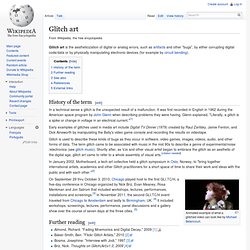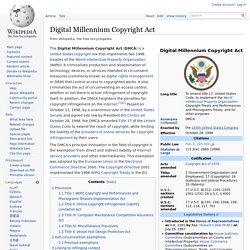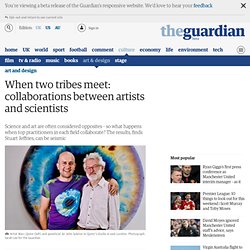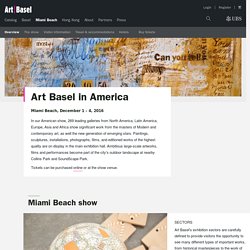

Glitch art. Glitch art is the aestheticization of digital or analog errors, such as artifacts and other "bugs", by either corrupting digital code/data or by physically manipulating electronic devices (for example by circuit bending).

History of the term[edit] In a technical sense a glitch is the unexpected result of a malfunction. It was first recorded in English in 1962 during the American space program by John Glenn when describing problems they were having, Glenn explained, "Literally, a glitch is a spike or change in voltage in an electrical current. "[1] Early examples of glitches used in media art include Digital TV Dinner (1979) created by Raul Zaritsky, Jamie Fenton, and Dick Ainsworth by manipulating the Bally's video game console and recording the results on videotape. Further reading[edit] Almond, Richard. See also[edit] References[edit] External links[edit] Digital Millennium Copyright Act. The Digital Millennium Copyright Act (DMCA) is a United States copyright law that implements two 1996 treaties of the World Intellectual Property Organization (WIPO).

It criminalizes production and dissemination of technology, devices, or services intended to circumvent measures (commonly known as digital rights management or DRM) that control access to copyrighted works. It also criminalizes the act of circumventing an access control, whether or not there is actual infringement of copyright itself. In addition, the DMCA heightens the penalties for copyright infringement on the Internet.[1][2] Passed on October 12, 1998, by a unanimous vote in the United States Senate and signed into law by President Bill Clinton on October 28, 1998, the DMCA amended Title 17 of the United States Code to extend the reach of copyright, while limiting the liability of the providers of online services for copyright infringement by their users. Provisions[edit] Title IV: Miscellaneous Provisions[edit] Facebook. How to Make the World Suck Less.
When two tribes meet: collaborations between artists and scientists. Yes, Leonardo da Vinci was both artist and inventor.

True, Brian Cox was in that band before he gave it all up for the Large Hadron Collider. But in general, art and science seem to eye each other uncomprehendingly. Medical research charity the Wellcome Trust has long tried to make artists and scientists work fruitfully together by funding collaborations. Can the divide ever be breached? I talked to four scientists and four artists who have worked together to find out. The artist and the geneticist Just before 9/11, Marc Quinn did a portrait of Sir John Sulston, one of the genetic scientists who decoded the human genome. It was a radical departure for portraiture. "Well, yes," says Sulston, "but DNA gives the instructions for making a baby, not an adult. A decade after their collaboration, Quinn and Sulston are meeting in the artist's east London studio. "Science simply means finding out about stuff, but in that process science is the greatest driver of culture," says Sulston.
Is This Photo Ethical? Back in March there was a heated debate about this photo taken of 15-year-old Fabienne Cherisma, who was shot and killed by police after stealing two two plastic chairs and three framed pictures.

It reminded me much about my recent blog post about Ethics and Street Photography. One of the photos shot by photographer Paul Hansen, was chosen as the best International News Image at the Swedish Picture of the Year Awards. In March 2010, Hansen discussed the image and circumstances of Fabienne’s death stating, “For me, Fabienne’s death and her story is a poignant reminder of the need for a society to have basic security – with or without a disaster.” Looking at the image above, it is a very emotional image that does bring great amounts of awareness to this horrible issue. However when looking at the photo below shot by photographer Nathan Weber, I feel that the story changes. Via Prison Photography and PetaPixel. So what do you think, do you think this image is ethical? 4/10/11 Update: Basel - Transcripts 2002-2011. Terms of use (disclaimer) for the MCH Group's websites In opening and using this website, you agree to the following conditions.

The term "MCH" used on this website refers to MCH Group Ltd. and all the MCH Group Ltd. companies affiliated to MCH Group Ltd. MCH Swiss Exhibition (Basel) Ltd. as a subsidiary of MCH Group Ltd. is the organiser of the international art show "Art Basel in Basel". MCH Swiss Exhibition (Basel) Ltd.'s subsidiaries Art Basel U.S. Provisions and conditions 1. 2. 3. Uploads/ART EXPERIMENT/Garage Release Art Experiment.pdf. Miamibeach.artbasel.com/global/show_document.asp?id=aaaaaaaaaaaywbn.